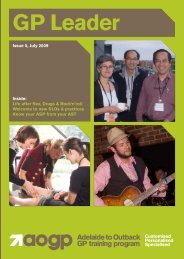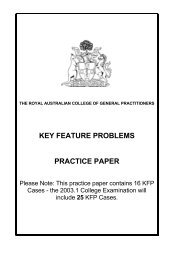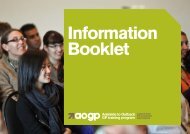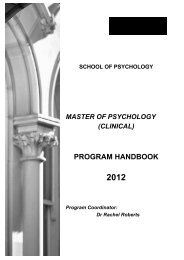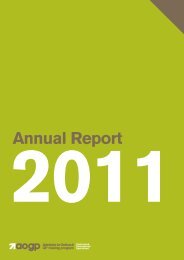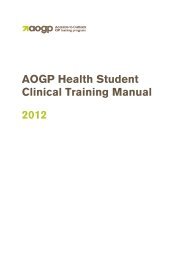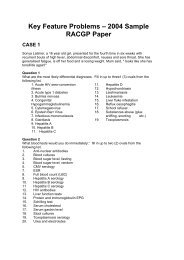Annual Report - Adelaide to Outback GP Training Program
Annual Report - Adelaide to Outback GP Training Program
Annual Report - Adelaide to Outback GP Training Program
You also want an ePaper? Increase the reach of your titles
YUMPU automatically turns print PDFs into web optimized ePapers that Google loves.
Notes <strong>to</strong> the financial statements (continued)<br />
for the year ended December 31 2010<br />
NOTE 1: STATEMENT OF SIGNIFICANT ACCOUNTING POLICIES (CONTINUED)<br />
b. Property, Plant and Equipment (continued)<br />
The depreciation rates used for each class of depreciable assets are:<br />
Class of Fixed Asset Depreciation Rate<br />
Plant and equipment 20%<br />
Office furniture and fittings 14.3-33.3%<br />
Computers 33.3%<br />
Leasehold improvements 14.3-50%<br />
The assets’ residual values and useful lives are reviewed and adjusted, if appropriate, at the end of each<br />
reporting period.<br />
An asset’s carrying amount is written down immediately <strong>to</strong> its recoverable amount if the asset’s carrying<br />
amount is greater than its estimated recoverable amount.<br />
Gains and losses on disposals are determined by comparing proceeds with the carrying amount. These gains<br />
and losses are included in the statement of comprehensive income.<br />
c. Leases<br />
Operating Leases<br />
Lease payments for operating leases, where substantially all the risks and benefits remain with the lessor, are<br />
charged as expenses on a straight-line basis over the lease term.<br />
Lease incentives under operating leases are recognised as a liability and amortised on a straight-line basis<br />
over the life of the lease term.<br />
d. Financial Instruments<br />
Initial recognition and measurement<br />
Financial assets and financial liabilities are recognised when the Association becomes a party <strong>to</strong> the<br />
contractual provisions <strong>to</strong> the instrument. For financial assets, this is equivalent <strong>to</strong> the date that the Association<br />
commits itself <strong>to</strong> either purchase or sell the asset. Financial instruments are initially measured at fair value plus<br />
transaction costs except where the instrument is classified ‘at fair value through profit or loss’ in which case<br />
transaction costs are expensed <strong>to</strong> the statement of comprehensive income immediately. The Association’s<br />
financial instruments are mainly cash and cash equivalents, receivables and payables.<br />
Classification and subsequent measurement<br />
Financial instruments are subsequently measured at either fair value, amortised cost using the effective interest<br />
rate method or cost. Fair value represents the amount for which an asset could be exchanged or a liability<br />
settled, between knowledgeable, willing parties. Where available, quoted prices in an active market are used<br />
<strong>to</strong> determine fair value. In other circumstances, valuation techniques are adopted. Amortised cost is calculated<br />
as: (i) the amount at which the financial asset or financial liability is measured at initial recognition; (ii) less<br />
principal repayments; (iii) plus or minus the cumulative amortisation of the difference, if any, between the<br />
amount initially recognised and the maturity amount calculated using the effective interest method; and (iv) less<br />
any reduction for impairment.<br />
34



